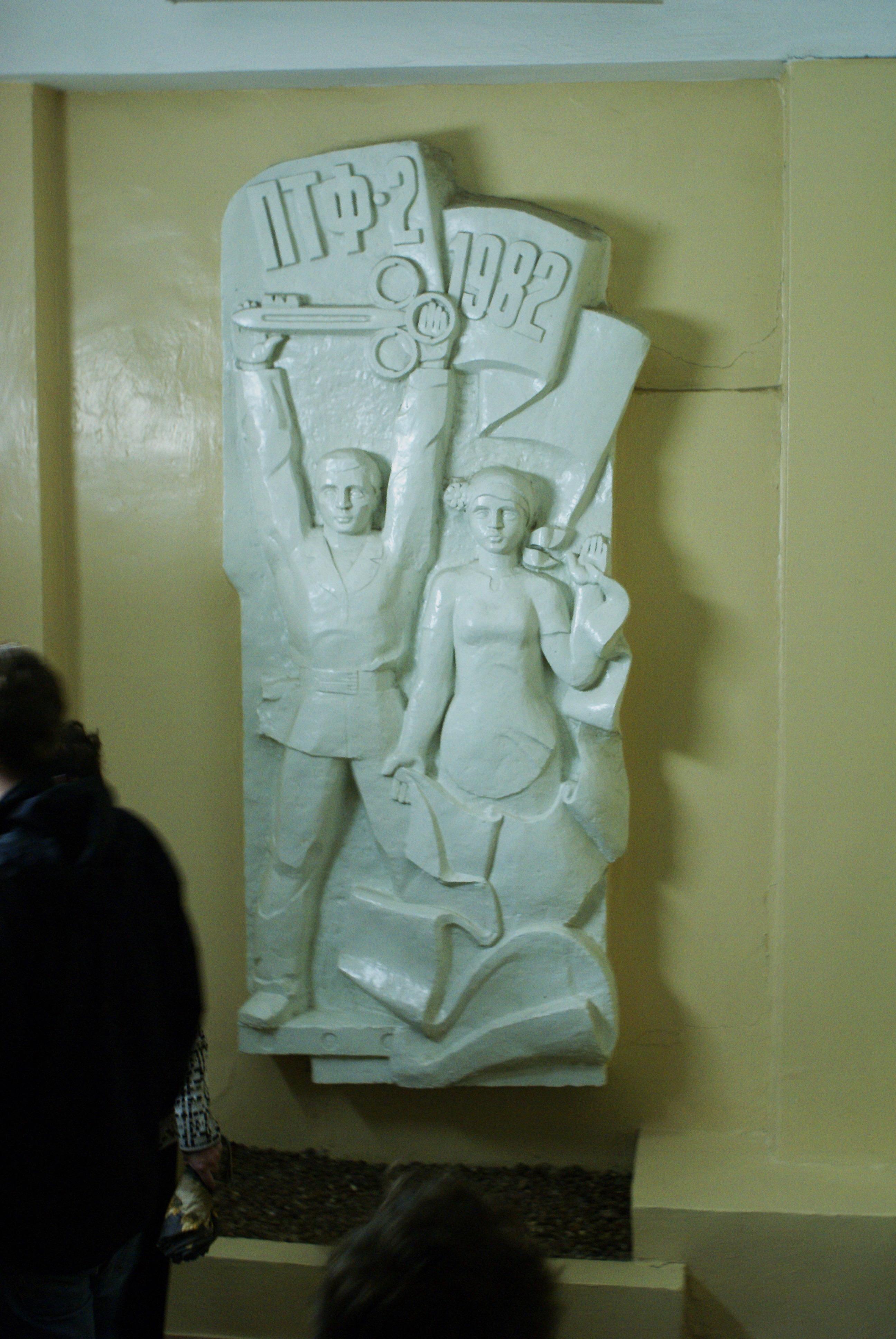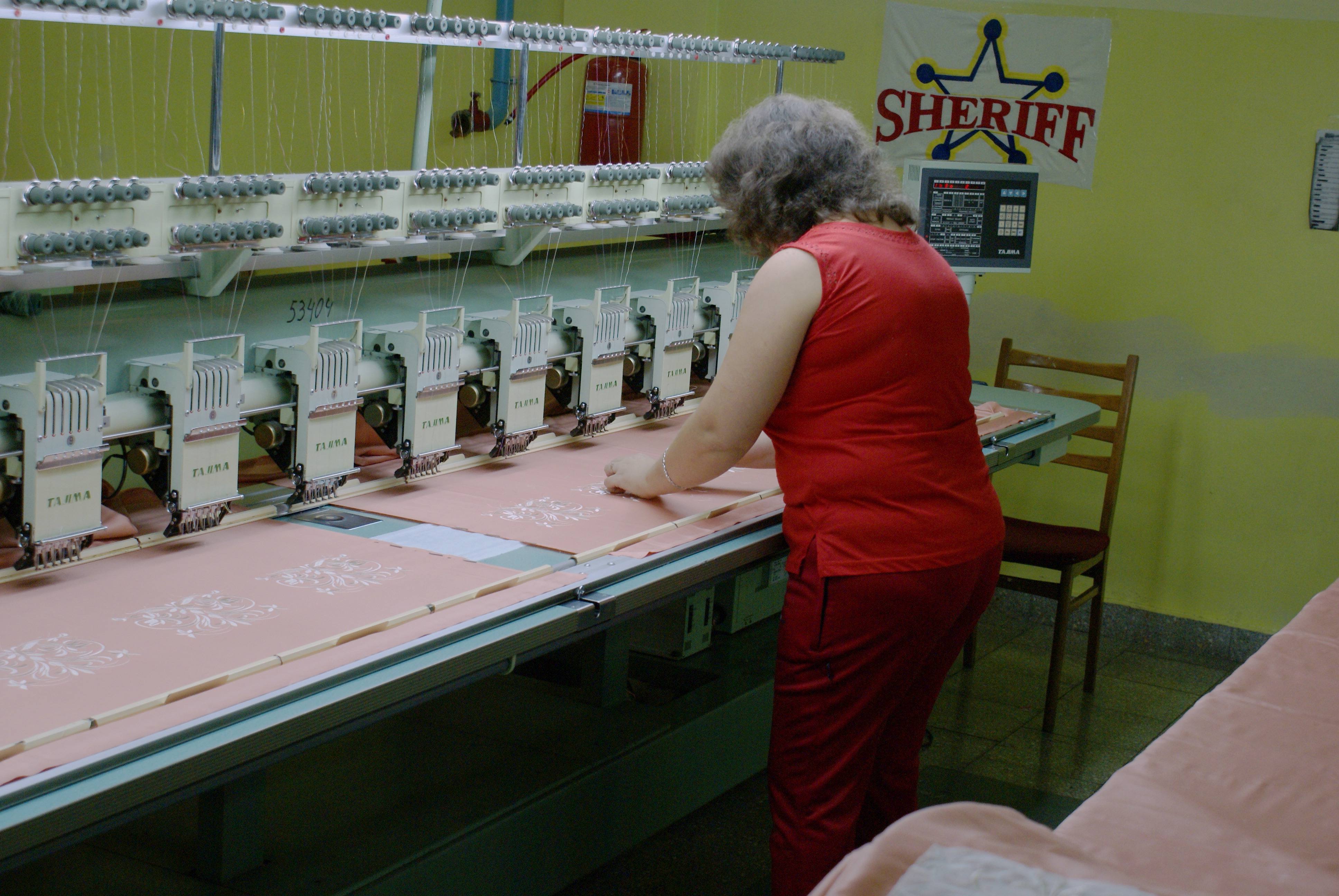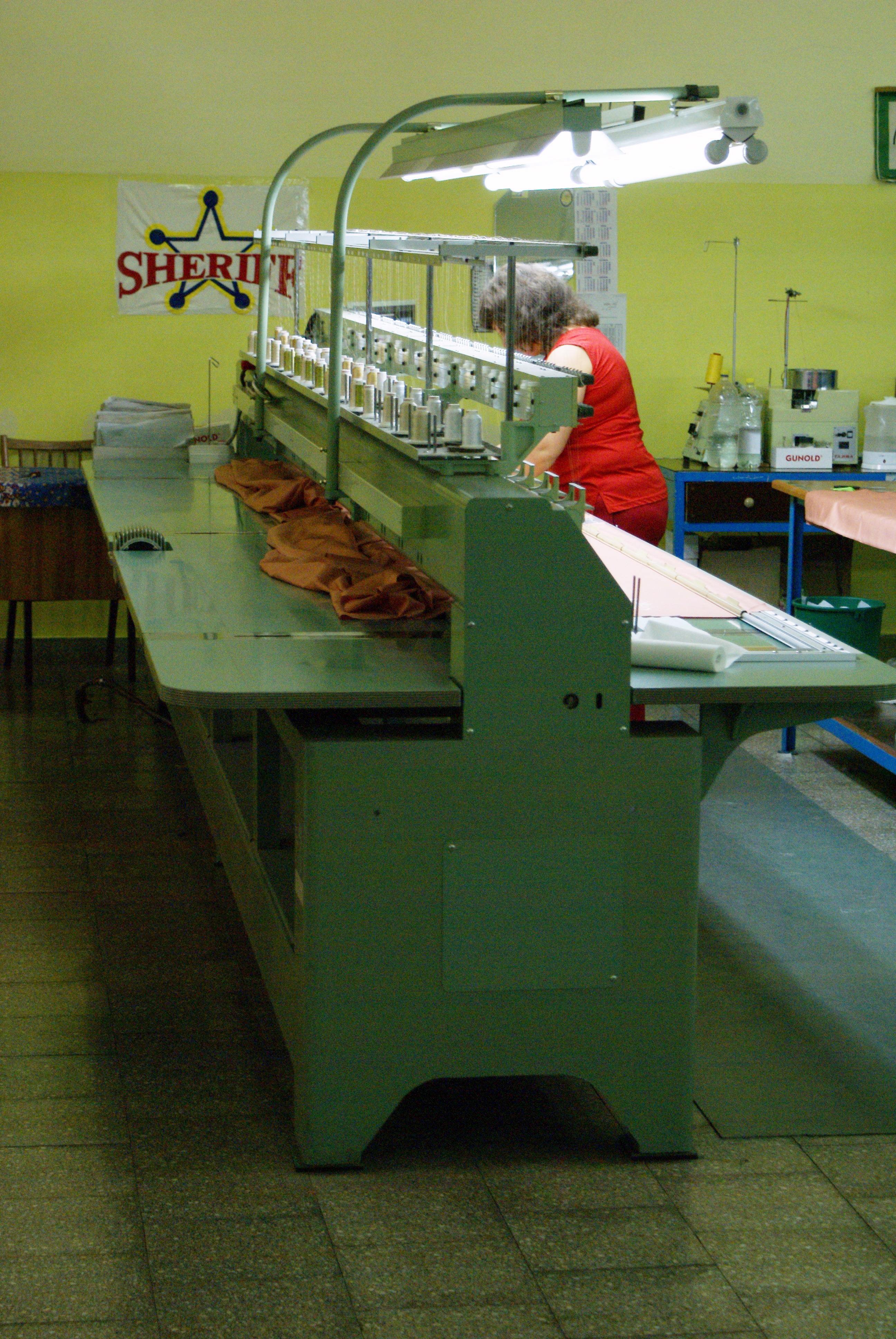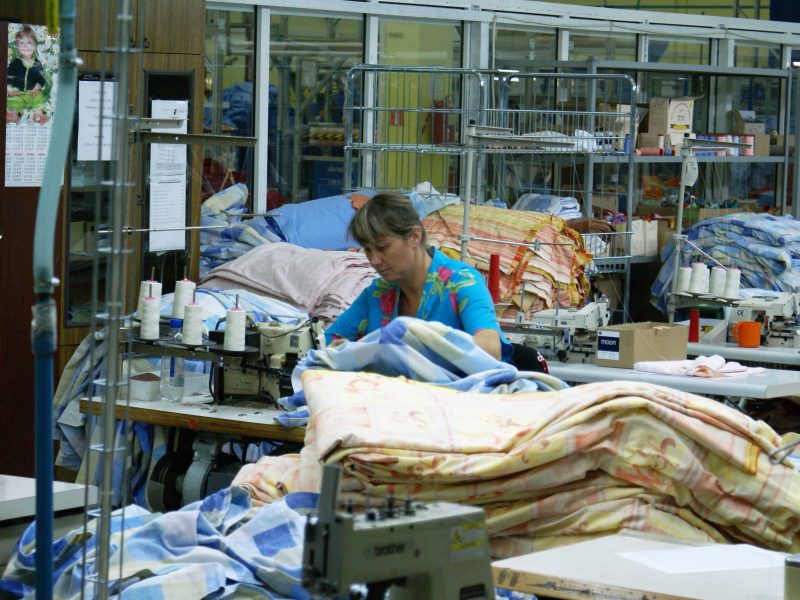
13 Photos
Europeans Sleep on Transnistrian Sheets
Europeans Sleep on Transnistrian Sheets
Source:Transnistria is said to be the most isolated part of Europe. Tucked away somewhere along the border with “the East”, the quasi-statelet’s independence is recognized by no one – not even the Kremlin. But Transnistrians have been eager to throw themselves into Russia’s arms, even though the economy of the disputed territory is still heavily dependent on Western Europe.[separator type="thin"]
The first time I called a Transnistrian company, I expected an answer from your stereotypical Eastern European secretary -- a grumpy, middle-aged woman with red nails and excessive amounts of eye shadow. My questions would all be answered with a categorical, Soviet-style nyet.
But Transnistria isn’t always what you expect it to be.
"Good morning! I’m the director of the marketing department,” an amiable voice answered in perfect English. "I’m the spokesman for Tirotex. How may I assist you?" I have to admit that before dialing the number of the textile company based in the Transnistrian capital of Tiraspol, I thought I'd get lost in a frustrating Kafkaesque loop of never-ending transfers from one department to another. Instead, someone answered my call in a friendly voice. I forgot what I was supposed to say next.
"Is this Tiraspol?"
The day before my phone call, March 18, Transnistria’s parliament had asked the Russian State Duma to allow its territory to become part of Russia.
In the early 1990s, a violent civil war between Moldova and pro-Russian separatists from the other side of the river Dniester broke out, and Russia has extended its protective wing over the region ever since. Russian troops are still stationed there to this day. After Russia’s de facto annexation of Crimea on March 16, the secessionist enclave has expressed its own desire to be reunited with the “Motherland”.
[caption id="attachment_3307" align="aligncenter" width="577"]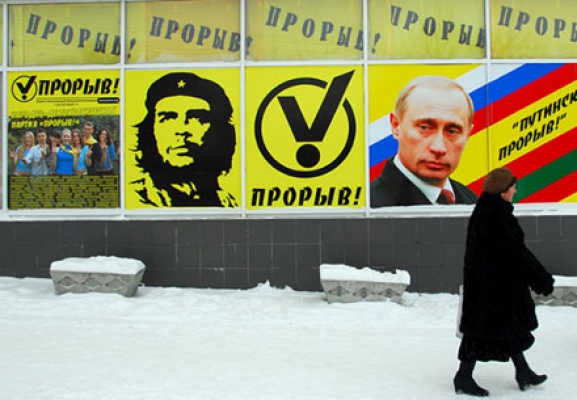 A poster for a Transnistrian youth organization in Tiraspol.[/caption]
Transnistria, or Trans-Dniester, is often described as one of the last vestiges of the former Soviet Union. Customs officers are stationed along its effectively nonexistent border with Moldova, it has its own telecommunications system, and boasts a currency that can’t be exchanged anywhere in the world. Transnistrian identity rests with an empire long gone. It’s often said that the small strip of land located between the Dniester river and the border with Ukraine is the most isolated in Europe. Transnistria is the last "republic" that still flies a flag with the hammer and sickle -- even though the USSR mother ship has sunk.
But regardless of how much Transniester tries to assert its independence -- which has yet to be recognized by any country, not even Russia -- and no matter how much it accentuates its Russian identity, the economy of the mostly Russian-speaking territory is still deeply intertwined with the economies of Moldova and Western Europe.
The mammoth textile company Tirotex, exemplifies the depth of Transnistria’s economic ties with the West. Tirotex claims to be one of the biggest companies of its kind in Europe, and produces bed linens, tablecloths, and drapes. A full 30 percent of its products are exported to Italy, while 20 percent go to Russia and the CIS, and about 20 percent to Germany.
Transnistrian sheets cover European beds thanks to something called the EUR-1 certificate, which is issued by Brussels. It guarantees the Moldovan origin of a product and allows exports free of customs duties and taxes to the EU. The certificate is part of a preferential agreement extended to Moldova as a reward for choosing the EU as a partner for its development efforts. It will remain in force until 2015, along with a free trade agreement between Brussels and the Moldovan government in Chisinau. The certificate applies to every product (save for a few items in the agricultural sector) and any company in Transniester with a registered address in Chisinau can apply for one. This is how Tirotex have been able to export its sheets to Western Europe.
In fact, Tirotex exported $163 million worth of its textiles to Europe and the CIS in 2011, according to the Warsaw-based Center for Eastern Studies. The European Commission also reported that the EU imported $940 million worth of goods from the Republic of Moldova in 2012 -- mostly agricultural products, textiles, and machinery. Brussels does not distinguish between products from Transniester and products from Moldova. (Of course, neither does Moldova).
[caption id="attachment_3288" align="aligncenter" width="800"]
A poster for a Transnistrian youth organization in Tiraspol.[/caption]
Transnistria, or Trans-Dniester, is often described as one of the last vestiges of the former Soviet Union. Customs officers are stationed along its effectively nonexistent border with Moldova, it has its own telecommunications system, and boasts a currency that can’t be exchanged anywhere in the world. Transnistrian identity rests with an empire long gone. It’s often said that the small strip of land located between the Dniester river and the border with Ukraine is the most isolated in Europe. Transnistria is the last "republic" that still flies a flag with the hammer and sickle -- even though the USSR mother ship has sunk.
But regardless of how much Transniester tries to assert its independence -- which has yet to be recognized by any country, not even Russia -- and no matter how much it accentuates its Russian identity, the economy of the mostly Russian-speaking territory is still deeply intertwined with the economies of Moldova and Western Europe.
The mammoth textile company Tirotex, exemplifies the depth of Transnistria’s economic ties with the West. Tirotex claims to be one of the biggest companies of its kind in Europe, and produces bed linens, tablecloths, and drapes. A full 30 percent of its products are exported to Italy, while 20 percent go to Russia and the CIS, and about 20 percent to Germany.
Transnistrian sheets cover European beds thanks to something called the EUR-1 certificate, which is issued by Brussels. It guarantees the Moldovan origin of a product and allows exports free of customs duties and taxes to the EU. The certificate is part of a preferential agreement extended to Moldova as a reward for choosing the EU as a partner for its development efforts. It will remain in force until 2015, along with a free trade agreement between Brussels and the Moldovan government in Chisinau. The certificate applies to every product (save for a few items in the agricultural sector) and any company in Transniester with a registered address in Chisinau can apply for one. This is how Tirotex have been able to export its sheets to Western Europe.
In fact, Tirotex exported $163 million worth of its textiles to Europe and the CIS in 2011, according to the Warsaw-based Center for Eastern Studies. The European Commission also reported that the EU imported $940 million worth of goods from the Republic of Moldova in 2012 -- mostly agricultural products, textiles, and machinery. Brussels does not distinguish between products from Transniester and products from Moldova. (Of course, neither does Moldova).
[caption id="attachment_3288" align="aligncenter" width="800"] In Transnistria, the Sheriff conglomerate recently built a 15,000-capacity stadium, with eight auxiliary courts, a 8×8 training field, and a luxury hotel. (Photo credit: fc-sheriff.com)
In Transnistria, the Sheriff conglomerate recently built a 15,000-capacity stadium, with eight auxiliary courts, a 8×8 training field, and a luxury hotel. (Photo credit: fc-sheriff.com)[/caption]
The entire economy of Transniestria can more or less be reduced to five companies: a cement producer, a steel producer, Tirotex, Russian energy company Inter RAO UES, and Sheriff. The first three are oriented toward exports, while Inter RAO UES delivers gas to Transniester and Moldova. Sheriff consists of a diverse range of firms that provide Transniestrians with almost everything they need, including bread, mobile phones, fuel, alcohol, and football. In fact, the local football team now has the most modern stadium in the entire region, thanks to Sherriff. The company was established by two former KGB officers, and is currently the biggest employer in Transniester. Sheriff also controls Tirotex. These five companies generate an estimated GDP of $1 billion. Beyond that, a little money trickles in from elsewhere. Unofficially, the separatist territory receives humanitarian aid from Russia. Remittances, mostly from people working in Russia, are also high. (A third of the population left the territory in the 1990s and just 500,000 inhabitants remain).
Transniester has no middle class, and doesn’t receive any foreign direct investment. The territory, most agree, could not survive on its own.
But what would happen to Tirotex if Russia really did decide to absorb Transnistria, and close the textile company’s gates to the West?
"We can’t speak of such a thing, because there’s no legal framework for it in place,” the voice on the other end of the line at Tirotex says, before asking me to call back another time if I want more details.
Another day passes and I dial the number again, but this time there’s no friendly voice to greet me -- just the intermittent ringing of an unanswered telephone in Tiraspol.
Last week, Transniestrian leader Evgheni Șevciuk urged the government in Chisinau to recognize the region's independence, so that each side could choose its own path: Moldova would continue in the direction of the EU, NATO, and possibly Romania. Transniester would turn to Russia, marching towards what its leader has called a “blooming future”.
The quasi-state is reasserting its seriousness about secession. Last week’s meeting of the “5+2” group, which has been seeking a diplomatic solution to the ongoing conflict, was canceled when Transnistria refused to participate. And yesterday, Vladimir Putin made his own position clear in a live televised broadcast. “The people of Transnistria should be able to decide their fate for themselves,” he said. “Democracy allows them to live as they want.”
Transnistria is said to be the most isolated part of Europe. Tucked away somewhere along the border with “the East”, the quasi-statelet’s independence is recognized by no one – not even the Kremlin. But Transnistrians have been eager to throw themselves into Russia’s arms, even though the economy of the disputed territory is still heavily dependent on Western Europe.
The first time I called a Transnistrian company, I expected an answer from your stereotypical Eastern European secretary — a grumpy, middle-aged woman with red nails and excessive amounts of eye shadow. My questions would all be answered with a categorical, Soviet-style nyet.
But Transnistria isn’t always what you expect it to be.
“Good morning! I’m the director of the marketing department,” an amiable voice answered in perfect English. “I’m the spokesman for Tirotex. How may I assist you?” I have to admit that before dialing the number of the textile company based in the Transnistrian capital of Tiraspol, I thought I’d get lost in a frustrating Kafkaesque loop of never-ending transfers from one department to another. Instead, someone answered my call in a friendly voice. I forgot what I was supposed to say next.
“Is this Tiraspol?”
The day before my phone call, March 18, Transnistria’s parliament had asked the Russian State Duma to allow its territory to become part of Russia.
In the early 1990s, a violent civil war between Moldova and pro-Russian separatists from the other side of the river Dniester broke out, and Russia has extended its protective wing over the region ever since. Russian troops are still stationed there to this day. After Russia’s de facto annexation of Crimea on March 16, the secessionist enclave has expressed its own desire to be reunited with the “Motherland”.

Transnistria, or Trans-Dniester, is often described as one of the last vestiges of the former Soviet Union. Customs officers are stationed along its effectively nonexistent border with Moldova, it has its own telecommunications system, and boasts a currency that can’t be exchanged anywhere in the world. Transnistrian identity rests with an empire long gone. It’s often said that the small strip of land located between the Dniester river and the border with Ukraine is the most isolated in Europe. Transnistria is the last “republic” that still flies a flag with the hammer and sickle — even though the USSR mother ship has sunk.
But regardless of how much Transniester tries to assert its independence — which has yet to be recognized by any country, not even Russia — and no matter how much it accentuates its Russian identity, the economy of the mostly Russian-speaking territory is still deeply intertwined with the economies of Moldova and Western Europe.
The mammoth textile company Tirotex, exemplifies the depth of Transnistria’s economic ties with the West. Tirotex claims to be one of the biggest companies of its kind in Europe, and produces bed linens, tablecloths, and drapes. A full 30 percent of its products are exported to Italy, while 20 percent go to Russia and the CIS, and about 20 percent to Germany.
Transnistrian sheets cover European beds thanks to something called the EUR-1 certificate, which is issued by Brussels. It guarantees the Moldovan origin of a product and allows exports free of customs duties and taxes to the EU. The certificate is part of a preferential agreement extended to Moldova as a reward for choosing the EU as a partner for its development efforts. It will remain in force until 2015, along with a free trade agreement between Brussels and the Moldovan government in Chisinau. The certificate applies to every product (save for a few items in the agricultural sector) and any company in Transniester with a registered address in Chisinau can apply for one. This is how Tirotex have been able to export its sheets to Western Europe.
In fact, Tirotex exported $163 million worth of its textiles to Europe and the CIS in 2011, according to the Warsaw-based Center for Eastern Studies. The European Commission also reported that the EU imported $940 million worth of goods from the Republic of Moldova in 2012 — mostly agricultural products, textiles, and machinery. Brussels does not distinguish between products from Transniester and products from Moldova. (Of course, neither does Moldova).

The entire economy of Transniestria can more or less be reduced to five companies: a cement producer, a steel producer, Tirotex, Russian energy company Inter RAO UES, and Sheriff. The first three are oriented toward exports, while Inter RAO UES delivers gas to Transniester and Moldova. Sheriff consists of a diverse range of firms that provide Transniestrians with almost everything they need, including bread, mobile phones, fuel, alcohol, and football. In fact, the local football team now has the most modern stadium in the entire region, thanks to Sherriff. The company was established by two former KGB officers, and is currently the biggest employer in Transniester. Sheriff also controls Tirotex. These five companies generate an estimated GDP of $1 billion. Beyond that, a little money trickles in from elsewhere. Unofficially, the separatist territory receives humanitarian aid from Russia. Remittances, mostly from people working in Russia, are also high. (A third of the population left the territory in the 1990s and just 500,000 inhabitants remain).
Transniester has no middle class, and doesn’t receive any foreign direct investment. The territory, most agree, could not survive on its own.
But what would happen to Tirotex if Russia really did decide to absorb Transnistria, and close the textile company’s gates to the West?
“We can’t speak of such a thing, because there’s no legal framework for it in place,” the voice on the other end of the line at Tirotex says, before asking me to call back another time if I want more details.
Another day passes and I dial the number again, but this time there’s no friendly voice to greet me — just the intermittent ringing of an unanswered telephone in Tiraspol.
Last week, Transniestrian leader Evgheni Șevciuk urged the government in Chisinau to recognize the region’s independence, so that each side could choose its own path: Moldova would continue in the direction of the EU, NATO, and possibly Romania. Transniester would turn to Russia, marching towards what its leader has called a “blooming future”.
The quasi-state is reasserting its seriousness about secession. Last week’s meeting of the “5+2” group, which has been seeking a diplomatic solution to the ongoing conflict, was canceled when Transnistria refused to participate. And yesterday, Vladimir Putin made his own position clear in a live televised broadcast. “The people of Transnistria should be able to decide their fate for themselves,” he said. “Democracy allows them to live as they want.”







